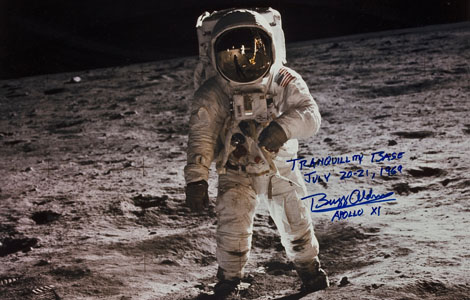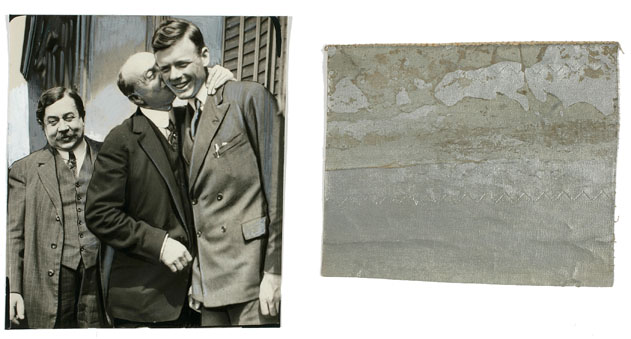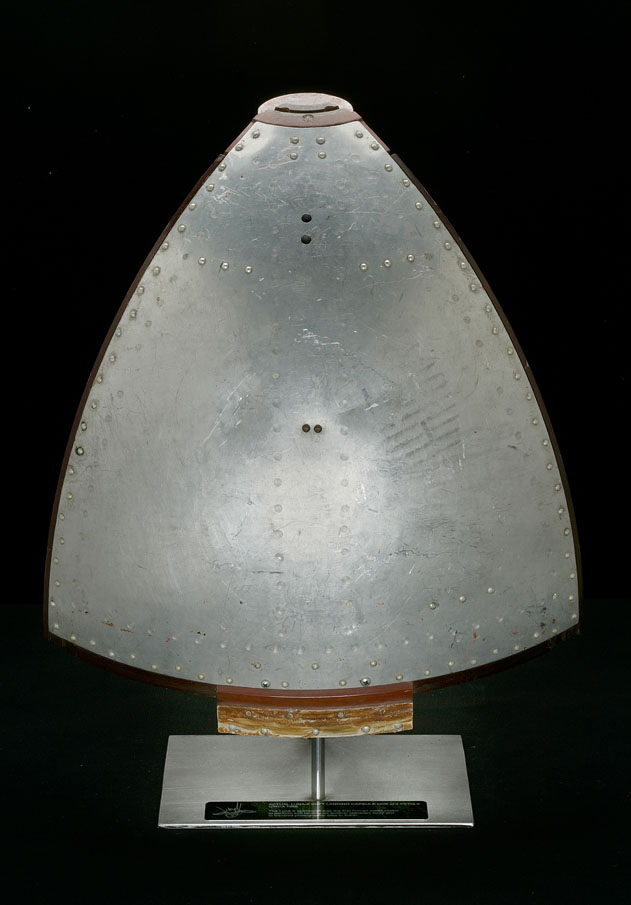Space History Items Bring $1 Million
To buy a piece of space history, you need plenty of cash
Have a spare $4,000 and can’t figure out what to spend it on? How about a plastic Snoopy astronaut doll, signed by Apollo 10 commander Tom Stafford? If that wasn’t exactly what you were looking for, there were hundreds of other items to be had at Bonhams’ fourth annual space history auction, held April 26: A painting by astronaut Alan Bean of Apollo 16 astronaut John Young leaping into history ($68,500); a rare Soviet space suit used during the 1969 docking of Soyuz 4 and 5 ($46,250); early Russian space posters (To Space—the Soviet way!—$1,500); a copy of Octave Chanute’s 1899 book Progress in Flying Machines, signed by the author himself ($1,187). See a few highlights from the auction, below.

One of the Apollo program's iconic images: Buzz Aldrin standing on the Moon. Image courtesy Bonhams.
This well-known image of Buzz Aldrin, taken on July 20, 1969 by Neil Armstrong, went for $5,250. The 16 x 20 inch photograph was signed and dated by Aldrin, the Apollo 11 lunar module pilot and second human to set foot on the moon.
When Charles Lindbergh landed his Spirit of St. Louis at Le Bourget, completing the world’s first nonstop solo flight across the Atlantic, the aircraft’s fuselage fabric was badly torn by souvenir-hunters. “I could feel the Spirit of St. Louis tremble with the pressure of the crowd,” Lindbergh would later write. “I heard the crack of wood behind me when someone leaned too heavily against a fairing strip. Then a second strip snapped, and a third, and there was the sound of tearing fabric…. It was essential to get a guard stationed around my plane before more damage was done.” This 4 x 5 inch piece of fabric, below—which went for $2,000—is believed to be from that historic day.

Fragment of silver-coated textile with a black-and-white photograph of Louis Bleriot congratulating Charles Lindbergh on his transatlantic flight. Image courtesy Bonhams.
This 1964, 250-page Project Gemini manual—signed by Buzz Aldrin, Gordon Cooper, Gene Cernan, Richard Gordon, Wally Schirra, Dave Scott, and Tom Stafford—was issued to both astronauts and support personnel. The manual, which includes fold-out schematics and diagrams, went for $9,375.
Looking for something a little larger? How about a nearly 8-foot-tall prototype lunar flagpole? Bonhams’ catalog notes, “About 3 months before Apollo 11, Robert Giruth asked Technical Services Division to design a flagpole that could support the U.S. flag in an environment with no atmosphere. It had to be lightweight, compact, and easily assembled by astronauts wearing pressurized space suits.

The prototype of the flag and staff placed on the Moon by the Apollo 11 crew fetched $43,750. Image courtesy Bonhams.
The team came up with a flagpole very similar to the present example. The Apollo 11 flagpole was attached to the left-hand side of Eagle’s ladder, and was protected from the heat of Eagle’s descent engines by a special heatproof shield. Aldrin has commented , ‘It took both of us to set it up and it was nearly a disaster…. As hard as we tried, the telescope wouldn’t fully extend. Thus the flag which should have been flat, had its own unique permanent wave. Then to our dismay the staff of the pole wouldn’t go far enough into the lunar surface to support itself in an upright position. After much struggling we finally coaxed it to remain upright, but in a most precarious position. I dreaded the possibility of the American flag collapsing into the lunar dust in front of the television camera.’”
In 1966, the Soviets achieved the first soft landing on the Moon with their unmanned spacecraft Luna 9, which was also the first spacecraft to transmit images from the lunar surface. After the spacecraft landed, four petals that covered the top half of the vessel opened outward, helping to stabilize the craft on the Moon’s surface. One surplus petal, identical to the four on Luna 9, sold at auction for $4,000.
One of the most beautiful items at the auction was this lunar planning chart, signed by a member of each Apollo lunar landing crew. The chart, which indicates every Apollo lunar landing site, also includes written notes by the astronauts about their various flights. “A dream of mankind becomes true!” writes Buzz Aldrin. The 45 x 42 inch chart sold at auction for $62,500.

A lunar planning chart—signed by a member of each Apollo lunar landing crew—sold for $62,500. Image courtesy Bonhams.

